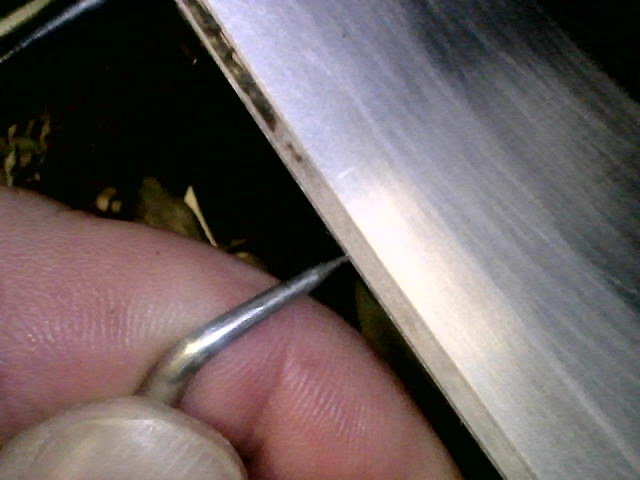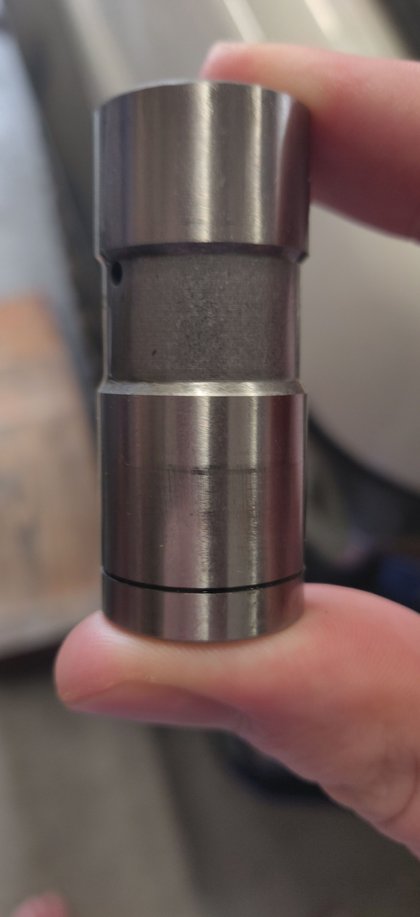Best way to determine a slipped sleeve
#1
So, I am losing my mind on this complete engine overhaul. I have already had it completely done and running. After about 300 miles of the initial break-in, it starts ticking real bad. So I start diagnosing and I think it is a slipped sleeve (still not 100% sure though). Some backstory on this block, when I first initially got my original block sent to the machine shop they had a accident and the block was essentially destroyed. They ended up getting a block from a junkyard 2003, they pull it apart and it had rust and pitting inside the cylinder on the sleeve. They ended up boring the sleeve out and got it honed, So I got the correct pistons and all that and got it reassembled.
So what I am trying to figure out is how should I go about testing for a slipped sleeve, currently I am making a homemade test kit where I can pressurize the cooling system on the block so I can see if any air/water is leaking through the cylinder. My first test went pretty well, only issue is where I mount my air hose the weld has minimal leaking so I will have to make a new one tomorrow. With my first initial test I did not notice any leakage through any of the cylinders, I worry about the actual block not being damaged enough where coolant wont leak through it (cause if im not mistaken, the block itself still has a solid cylinder all the way down then it has the sleeve to go over it). Is there any other way to determine if the sleeve is actually moving?
So what I am trying to figure out is how should I go about testing for a slipped sleeve, currently I am making a homemade test kit where I can pressurize the cooling system on the block so I can see if any air/water is leaking through the cylinder. My first test went pretty well, only issue is where I mount my air hose the weld has minimal leaking so I will have to make a new one tomorrow. With my first initial test I did not notice any leakage through any of the cylinders, I worry about the actual block not being damaged enough where coolant wont leak through it (cause if im not mistaken, the block itself still has a solid cylinder all the way down then it has the sleeve to go over it). Is there any other way to determine if the sleeve is actually moving?
#2
@freedom if all the liners are level with the top of the block none have slipped, once they slip they will never come back to true. Also a liner does not just slip it takes a significant overheat event with engine kept running.
I may be mistaken but I did not think you could over bore the 4.0/4.6 sleeves, honing I get. If the rust pitting was so bad it neededan over bore I would have refused the block
My bet is lifters or rocker arms.
What weight oil are you running
Ticks on old design V8's are hard to find here are a few things :
Wear /oil pressure related
I may be mistaken but I did not think you could over bore the 4.0/4.6 sleeves, honing I get. If the rust pitting was so bad it neededan over bore I would have refused the block
My bet is lifters or rocker arms.
What weight oil are you running
Ticks on old design V8's are hard to find here are a few things :
Wear /oil pressure related
- Rockers
- Lifters
- Push rods
- Camshaft/lifter combo
- Main bearing
- Connecting rod bearings
#3
#4
@freedom if all the liners are level with the top of the block none have slipped, once they slip they will never come back to true. Also a liner does not just slip it takes a significant overheat event with engine kept running.
I may be mistaken but I did not think you could over bore the 4.0/4.6 sleeves, honing I get. If the rust pitting was so bad it neededan over bore I would have refused the block
My bet is lifters or rocker arms.
What weight oil are you running
Ticks on old design V8's are hard to find here are a few things :
Wear /oil pressure related
I may be mistaken but I did not think you could over bore the 4.0/4.6 sleeves, honing I get. If the rust pitting was so bad it neededan over bore I would have refused the block
My bet is lifters or rocker arms.
What weight oil are you running
Ticks on old design V8's are hard to find here are a few things :
Wear /oil pressure related
- Rockers
- Lifters
- Push rods
- Camshaft/lifter combo
- Main bearing
- Connecting rod bearings
As of right now I cant tell you oil pressure cause its already pulled apart down to the pistons (the machine shop got involved and they want us to find out if it is the sleeves) Only one point in its life did it reach 220, which in reality is a common temperature to reach at a completely stock setup. I do have a brand new nissens radiator and 180 thermostat. Other than that it ran below 200 constantly, was planning on installing some additional fans on the front to push more air through it. Going on memory I think it started ticking when it would warm up (120-150), at operating temp (180-200) it was real loud, and you could hear it from every side of the vehicle. I was looking up fixes for slipped sleeves but id rather have pinning them my last resort, seeing how pretty much everything is brand new I want this engine to be in the best condition I can make it.
Last edited by Freedom38; 08-21-2020 at 12:15 AM.
#6
@Freedom38 Sounds like that number 4 might be your problem. You are correct 220 is not a significant overheat.
And to go with @Dave03S 5/anything is on the low end for these, LR spec'd 5 weight only when you had temps at -10F regularly 10/30 to 10/40 is the range for almost everything else.
And to go with @Dave03S 5/anything is on the low end for these, LR spec'd 5 weight only when you had temps at -10F regularly 10/30 to 10/40 is the range for almost everything else.
#7
#8
Exhaust leaks can sound pretty bad especially on the upper exhaust manifold gaskets, then you have the 2 lower gaskets. Run a treatment of Seafoam thru the intake and you'll find your exhaust leaks very quickly lol. Lifters can certainly tick, but the liner sound only happens when fully warm. If it's right away it's either exhaust or lifters.
#9

Hard to see in photo but there is a visible line where liner appears to be lower than the deck of the block. I dont know if that little gap would classify as the sleeve is moving or not.

cylinder 8 exhaust lifter, appears to have abnormal wear on side.

lifter from different cylinder, no abnormal wear compared to other lifter.
Even comparing to my 100K mile lifters there was no similar wear on any of them.
Sounds like that number 4 might be your problem. You are correct 220 is not a significant overheat.
And to go with Dave03S 5/anything is on the low end for these, LR spec'd 5 weight only when you had temps at -10F regularly 10/30 to 10/40 is the range for almost everything else.
And to go with Dave03S 5/anything is on the low end for these, LR spec'd 5 weight only when you had temps at -10F regularly 10/30 to 10/40 is the range for almost everything else.
Exhaust leaks can sound pretty bad especially on the upper exhaust manifold gaskets, then you have the 2 lower gaskets. Run a treatment of Seafoam thru the intake and you'll find your exhaust leaks very quickly lol. Lifters can certainly tick, but the liner sound only happens when fully warm. If it's right away it's either exhaust or lifters.
#10
So, I am losing my mind on this complete engine overhaul. I have already had it completely done and running. After about 300 miles of the initial break-in, it starts ticking real bad. So I start diagnosing and I think it is a slipped sleeve (still not 100% sure though). Some backstory on this block, when I first initially got my original block sent to the machine shop they had a accident and the block was essentially destroyed. They ended up getting a block from a junkyard 2003, they pull it apart and it had rust and pitting inside the cylinder on the sleeve. They ended up boring the sleeve out and got it honed, So I got the correct pistons and all that and got it reassembled.
So what I am trying to figure out is how should I go about testing for a slipped sleeve, currently I am making a homemade test kit where I can pressurize the cooling system on the block so I can see if any air/water is leaking through the cylinder. My first test went pretty well, only issue is where I mount my air hose the weld has minimal leaking so I will have to make a new one tomorrow. With my first initial test I did not notice any leakage through any of the cylinders, I worry about the actual block not being damaged enough where coolant wont leak through it (cause if im not mistaken, the block itself still has a solid cylinder all the way down then it has the sleeve to go over it). Is there any other way to determine if the sleeve is actually moving?
So what I am trying to figure out is how should I go about testing for a slipped sleeve, currently I am making a homemade test kit where I can pressurize the cooling system on the block so I can see if any air/water is leaking through the cylinder. My first test went pretty well, only issue is where I mount my air hose the weld has minimal leaking so I will have to make a new one tomorrow. With my first initial test I did not notice any leakage through any of the cylinders, I worry about the actual block not being damaged enough where coolant wont leak through it (cause if im not mistaken, the block itself still has a solid cylinder all the way down then it has the sleeve to go over it). Is there any other way to determine if the sleeve is actually moving?
HOWEVER, if your sleeves are slipping, the indicator would be the head gasket, which will show signs of being "hammered" by the sleeve going up and down.
02+ blocks have a physical interlock so they can't slip down as older motors can. HOWEVER, they could technically slide up a very very small amount into the head gasket. I find this situation very unlikely but some have sworn to have witnessed it in some measurable amount. 03/04 blocks are much worse for cracking like mine did, as the tooling down the head studs was worse in creation of the blocks and the space between liner and block is inconsistent due to again, worn tooling. Sad situation.
Hopefully some helpful thoughts here.
Why do you think it's a slipped sleeve currently?
Lifters seems like a reasonable cause.
-Greg
Last edited by 05TurboS2K; 08-22-2020 at 07:14 PM.


